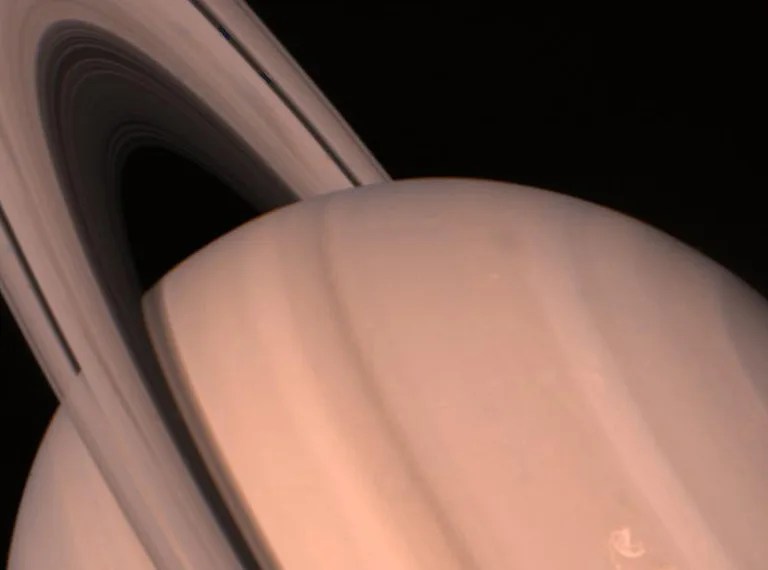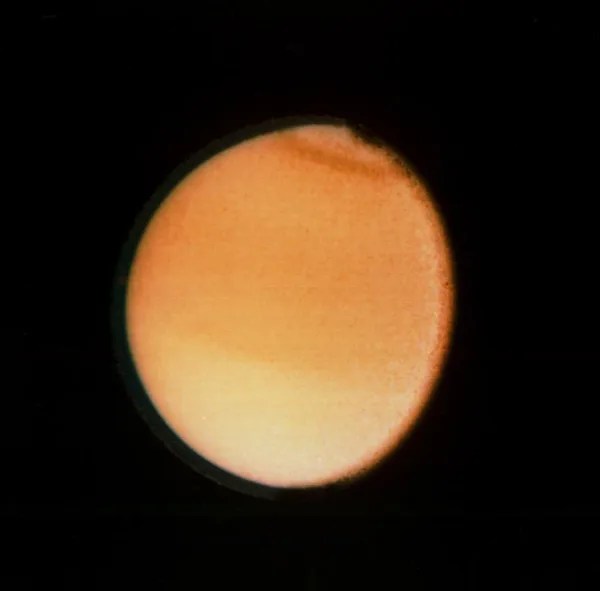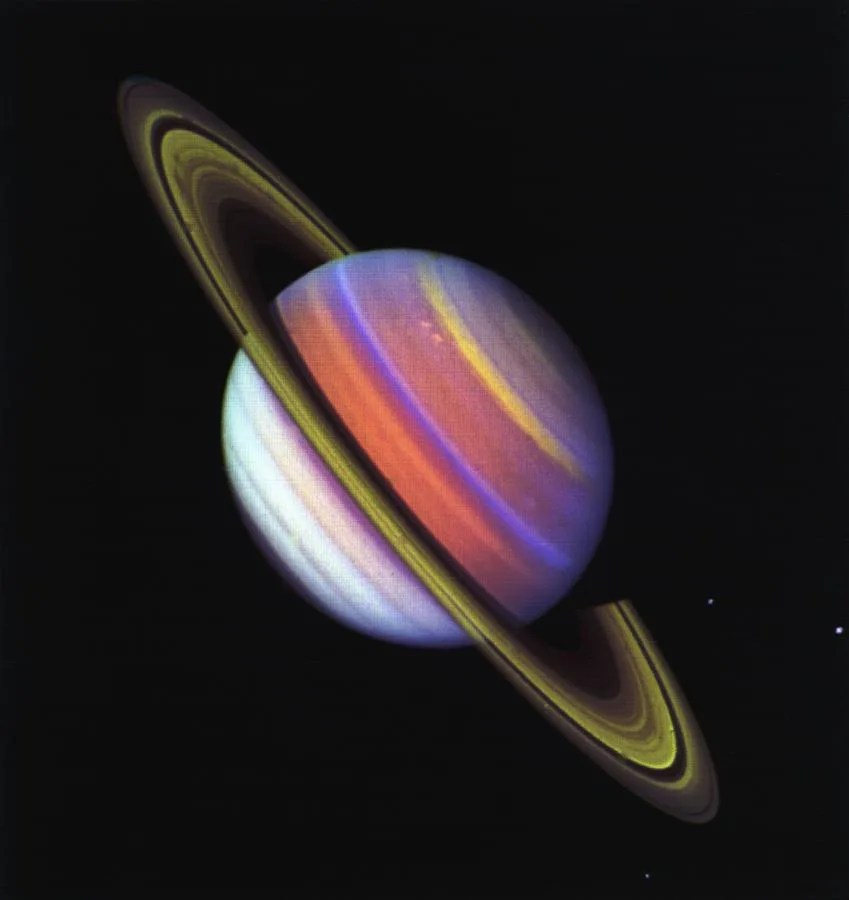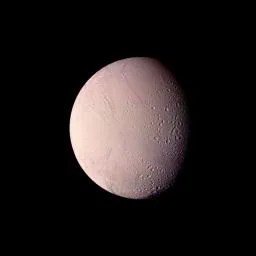6 min read

Saturn, with its alluring rings and numerous moons, has long fascinated stargazers and scientists. After an initial flyby of Pioneer 11 in 1979, humanity got a second, much closer look at this complex planetary system in the early 1980s through the eyes of NASA's twin Voyager spacecraft.
Voyager 2 made its closest approach to Saturn 40 years ago – on Aug. 25, 1981. What the Voyagers revealed at the planet was so phenomenal that, just one year later, a joint American and European working group began discussing a mission that would carry on the legacy of the Voyagers at Saturn. That mission – Cassini – studied the Saturn system for 13 years from 2004 to 2017. Cassini followed up on many of the Voyagers’ discoveries, and deepened our understanding of what some call a "mini solar system."
"Saturn, like all of the planets the Voyagers visited, was full of exciting discoveries and surprises," said Ed Stone, Voyager project scientist at NASA’s Jet Propulsion Laboratory (JPL) in Pasadena, California. "By giving us unprecedented views of the Saturn system, Voyager gave us plenty of reasons to go back for a closer look."
The Voyager Saturn flybys provided a thrilling look at the planet's moons – a diverse menagerie of worlds, each with unique character and charm. The Voyager images transformed the moons from points of light to fully realized places. Dramatic landscapes on Tethys, Dione, Rhea, Iapetus, and other moons tantalized scientists with features hinting at tortured pasts.
"The stars of the Saturn system are the moons, which surprised all of us on both the Voyager and Cassini missions," said Linda Spilker, project scientist for Cassini at JPL. Spilker also served on the Voyager science team.
One of the key findings of the Voyagers' visits to Saturn was that the planet's moons had evidence of past geological activity and that Enceladus – the brightest, most reflective planetary body scientists had ever seen – could still be active.
Cassini dove deeper into the nature of these moons and found that, indeed, icy Enceladus has geyser-like jets erupting from a liquid ocean beneath its surface. Cassini also confirmed that Enceladus is the source of Saturn's E ring, which was suggested by Voyager. But while Voyager images of wispy terrain hinted at ice volcanoes on Dione, Cassini found this feathery coating was actually a system of bright canyons.
Titan, Saturn's largest moon, was a high-priority target for the Voyager mission. Gerard Kuiper, for whom the Kuiper Belt is named, had discovered in 1944 that Titan had an atmosphere containing methane. Observations from both Voyagers showed that Titan's atmosphere was primarily composed of nitrogen, with a few percent methane and smaller amounts of other complex hydrocarbons, such as ethane, propane, and acetylene. No other moon in the solar system has a dense atmosphere.
Mission planners mapped out a path through the Saturn system that provided the gravitational boost needed to send Voyager 2 onward to Uranus. But because of intense interest in Titan's atmosphere, the giant moon was the higher priority. In fact, the team would have directed Voyager 2 much closer to Titan if Voyager 1 had not been successful in observing it.
"To fly close to Titan, Voyager 2 would have swung upward out of the plane of the planets, and couldn't have gone on to visit any others," Stone said. "It was fortunate that Voyager 1's observations of Titan went flawlessly so that Voyager 2 could continue traveling to Uranus and Neptune."
To the Voyagers, Titan appeared as a featureless orange ball because of the dense haze in its atmosphere. Seeing through this haze was a chief goal of the Cassini mission. Cassini carried cameras with infrared vision that could see through the haze, a radar that could map the surface in detail, and the European Huygens probe, which landed on the moon's frigid surface on Jan. 14, 2005. We now know, thanks to Cassini, that smoggy Titan has methane lakes and flooded canyons.
The Voyager missions discovered new moons and sharpened our view of some that were previously known. The spacecraft also revealed how the gravitational pull of these moons causes ripples in Saturn's rings, much like the wake of a ship on the sea. There were also surprising gaps in the rings, some caused by moons embedded within them.
Voyager 2 revealed an immense hexagonal feature in the clouds that surrounded Saturn's north pole, which Cassini found was still going strong a quarter-century later.
Additionally, the two Voyager spacecraft measured the wind speeds, temperature, and density of Saturn's atmosphere. With the Voyagers’ measurements as a starting point, Cassini further explored how Saturn's atmosphere changes with the seasons.
While both Voyager missions vastly improved our understanding of Saturn, its rings, and moons, there were still mysteries galore to explore with Cassini.
"The twin Voyagers rewrote the textbooks on Saturn, its rings and moons, and we couldn't wait to go back with Cassini," Spilker said.
Cassini was the first spacecraft to orbit Saturn. The mission yielded troves of new insights over more than a decade and changed the course of future planetary exploration.
Spilker delights in Cassini's string of remarkable discoveries, which were enabled by Voyager's earlier reconnaissance – findings about Saturn's magnificent rings, its amazing moons, its dynamic magnetosphere, and Titan's surface and atmosphere. "Some of the mission highlights included discovering that Titan has Earth-like processes and that the small moon Enceladus has a hot-spot at its southern pole, plus jets on the surface that spew out ice crystals, and liquid water beneath its surface," she said.
Voyager 1 and Voyager 2 have been flying longer than any other spacecraft in history. Continuing on their decades-long journeys since their 1977 launches, they each are much farther away from Earth and the Sun than Pluto.
In August 2012, Voyager 1 made the historic entry into interstellar space, the region between stars. Voyager 2 entered interstellar space on November 5, 2018. Both spacecraft are still sending scientific information about their surroundings through NASA’s Deep Space Network, or DSN.
Building on the work of the two Voyagers and Cassini, NASA will launch an 8-bladed rotorcraft called Dragonfly to explore Saturn’s largest moon, Titan. Slated for launch in 2026 and arrival in 2034, Dragonfly will sample and examine dozens of promising sites around Saturn’s icy moon and advance our search for the building blocks of life.
And NASA scientists still haven't had nearly enough of Enceladus. Researchers are actively exploring ideas for future missions that could someday swoop down to sample the moon's plume for signs of life, or perhaps even dive down into the ocean itself.
But all future missions to Saturn will stand on the shoulders of the trailblazing Voyagers and the first detailed look they provided at the Saturn system.
Note: This is an update of a story originally published on Aug. 23, 2016.










